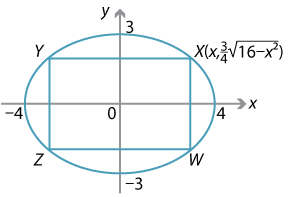Answers to exercises
Exercise 1
We can form a gradient diagram for this function.
| Value of \(x\) | 1 | 3 | |||
|---|---|---|---|---|---|
| Sign of \(f'(x)\) | − | 0 | − | 0 | + |
| Slope of graph \(y=f(x)\) | \(\diagdown\) | — | \(\diagdown\) | — | \(\diagup\) |
There is a stationary point of inflexion at \(x=1\), and a local minimum at \(x=3\).
Exercise 2
Let \(f(x) = x^3-5x^2+3x+2\). The derivative is \(f'(x) = 3x^2-10x+3 = (3x-1)(x-3)\). So the stationary points are \(x=\dfrac{1}{3}\) and \(x=3\).- When \(x<\dfrac{1}{3}\), \(f'(x)>0\).
- When \(\dfrac{1}{3}<x<3\), \(f'(x)<0\).
- When \(x>3\), \(f'(x)>0\).
Exercise 3
The inflexion points are \(x=0\) and \(x=-14\).Exercise 4
We are given \(f'(x) = x^3(x^2-5) = x^5 -5x^3\). So the stationary points are \(x=0\), \(x=\sqrt{5}\) and \(x= -\sqrt{5}\). The second derivative is \(f''(x) = 5x^4-15x^2 = 5x^2(x^2 - 3)\).- \(f''(0) = 0\), so we cannot use the second derivative test for \(x=0\). However, note that \(f'(-1) = 4\) and \(f'(1) = -4\). The gradient changes from positive to negative at \(x=0\). Hence, there is a local maximum at \(x=0\).
- \(f''(\sqrt{5}) = 50 > 0\), so there is a local minimum at \(x= \sqrt{5}\).
- \(f''(-\sqrt{5}) = 50 > 0\), so there is a local minimum at \(x=- \sqrt{5}\).
Exercise 5
Let \(y = 3x^4-44x^3+ 144x^2\). Then the first and second derivatives are
\begin{align*} \dfrac{dy}{dx} &= 12x^3-132x^2+288x = 12x(x^2-11x+24) = 12x(x-3)(x-8) \\ \dfrac{d^2y}{dx^2} &= 36x^2-264x+288 = 12(3x^2-22x+24) = 12(3x-4)(x-6). \end{align*}- We first find the \(x\)-intercepts: \begin{align*} 3x^4-44x^3+144x^2 &= 0 \\ x^2(3x^2-44x+144) &= 0, \end{align*} which gives \(x=0\) or \(x=\dfrac{2}{3}(11-\sqrt{13})\) or \(x=\dfrac{2}{3}(11+\sqrt{13})\).
- We have \(\dfrac{dy}{dx}=12x(x-3)(x-8)\). So \(\dfrac{dy}{dx}=0\) implies \(x=0\) or \(x=3\) or \(x=8\).
-
Value of \(x\) 0 3 8 Sign of \(\dfrac{dy}{dx}\) − 0 + 0 − 0 + Slope of graph \(\diagdown\) — \(\diagup\) — \(\diagdown\) — \(\diagup\) - We use the second derivative test:
- at \(x=0\), we have \(\dfrac{d^2y}{dx^2} = 288 > 0\), so there is a local minimum
- at \(x=3\), we have \(\dfrac{d^2y}{dx^2} = -180 < 0\), so there is a local maximum
- at \(x=8\), we have \(\dfrac{d^2y}{dx^2} = 480 > 0\), so there is a local minimum.
- As \(x \to \infty\), \(y \to \infty\), and as \(x \to -\infty\), \(y \to \infty\).
- \(\dfrac{d^2y}{dx^2} =0\) implies \(x = \dfrac{4}{3}\) or \(x=6\). The second derivative changes from positive to negative at \(x=\dfrac{4}{3}\), and from negative to positive at \(x=6\). So there are points of inflexion at \(x=\dfrac{4}{3}\) and \(x=6\).
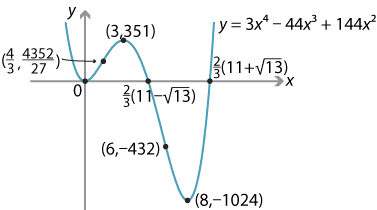
Exercise 6
Let \(y=4x^3-18x^2+48x-290\). The first and second derivatives are \begin{align*} \dfrac{dy}{dx} &= 12x^2-36x+48 = 12(x^2-3x+4) \\ \dfrac{d^2y}{dx^2} &= 12(2x-3). \end{align*}- The \(y\)-intercept is \(y=-290\). We now find the \(x\)-intercepts: \begin{align*} 4x^3-18x^2+48x-290 &= 0 \\ 2x^3-9x^2+24x-145 &= 0 \\ (x-5)(2x^2+x+29) &= 0. \end{align*} The quadratic has no real solutions, and so the only \(x\)-intercept is \(x=5\).
- \(\dfrac{dy}{dx} = 12(x^2-3x+4)\). The discriminant is \(12(9-16)<0\). Hence, \(\dfrac{dy}{dx}>0\), for all \(x\), and there are no stationary points.
- The function is increasing, for all \(x\).
- There are no local maxima or minima.
- As \(x \to \infty\), \(y \to \infty\), and as \(x \to -\infty\), \(y \to -\infty\).
- \(\dfrac{d^2y}{dx^2} = 12(2x-3)\). The second derivative changes from negative to positive at \(x=\dfrac{3}{2}\). So there is a point of inflexion at \(x=\dfrac{3}{2}\).
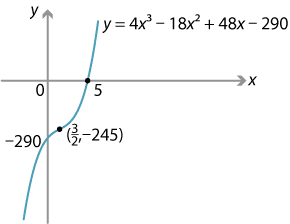
Exercise 7
Define \(f \colon (0,\infty) \to \mathbb{R}\) by \(f(x) = x^2\log_e x\). Then \begin{align*} f'(x) &= 2x\log_e x + x^2 \times \dfrac{1}{x} = 2x\log_e x + x = x(2\log_e x + 1) \\ f''(x) &= 2\log_e x + 2 + 1 = 2\log_e x + 3. \end{align*}- For \(x > 0\), we have \(f(x) = 0 \iff \log_e x = 0 \iff x = 1\). So the \(x\)-intercept is 1.
- We have \(f'(x) = x(2\log_e x + 1)\). So \(f'(x) = 0\) implies \(x = e^{-\frac{1}{2}}\). There is a stationary point at \(x = e^{-\frac{1}{2}}\).
- We have \[ f'(x) > 0 \ \iff\ x(2\log_e x + 1) > 0 \ \iff\ 2\log_e x + 1 > 0 \ \iff\ x > e^{-\frac{1}{2}}, \] and so \(f'(x) < 0 \iff 0 < x < e^{-\frac{1}{2}}\).
- \(f''(e^{-\frac{1}{2}}) = 2 > 0\). Hence, there is a local minimum at \(x = e^{-\frac{1}{2}}\).
- As \(x \to \infty\), \(f(x) \to \infty\).
- We have \(f''(x) = 2\log_e x + 3\). So \[ f''(x) > 0 \ \iff\ x > e^{-\frac{3}{2}}, \qquad f''(x) < 0 \ \iff\ 0 < x < e^{-\frac{3}{2}}. \] There is a point of inflexion at \(x=e^{-\frac{3}{2}}\).
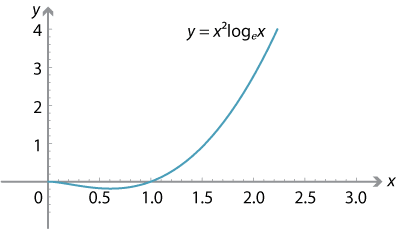
A second graph is drawn here to highlight the important points.
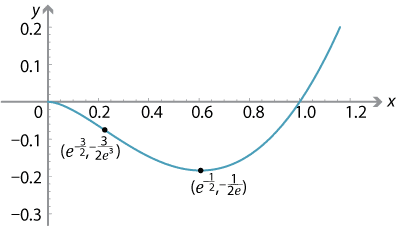
Exercise 8
Define \(f \colon [-1,2] \to \mathbb{R}\) by \(f(x) = x^2(x+4)\). The first and second derivatives are \[ f'(x) = 3x^2+8x,\qquad f''(x) = 6x+8. \] So \(f'(x) = 0\) when \(x=0\) or \(x=-\dfrac{8}{3}\). The second value is outside the required domain. Since \(f''(0) = 8 > 0\), there is a local minimum at \(x=0\), with \(f(0) = 0\). We now find the value of the function at the endpoints: \(f(-1) = 3\) and \(f(2) = 24\).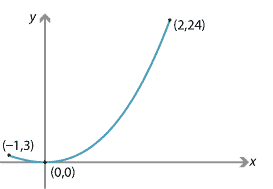
The minimum value of the function is 0 and the maximum value is 24.
Exercise 9
Let \(x\) km, \(x\) km and \(y\) km be the lengths of fencing of the three sides of the rectangle to be enclosed. Then \(y = 8 - 2x\).
Let \(A(x)\) km\(^2\) be the area of the enclosed land. Then \(A(x) = x(8-2x) = 8x-2x^2\). The first two derivatives are
\[ A'(x) = 8 -4x \qquad\text{and}\qquad A''(x) = -4. \]So \(A'(x) = 0\) implies \(x = 2\). Since \(A''(2) = -4 < 0\), there is a local maximum at \(x = 2\). The rectangle of maximum area has dimensions 2 km \(\times\) 4 km, and the maximum area is 8 km\(^2\).
Exercise 10
- The ellipse has equation \(\dfrac{x^2}{16}+\dfrac{y^2}{9} = 1\). Assume the top-right corner of the rectangle is at \(X(x, \dfrac{3}{4}\sqrt{16-x^2})\). The area \(A\) of the rectangle \(XYZW\) is given by \[ A = XY \times XW = 2x \times \dfrac{3}{2}\sqrt{16-x^2} = 3x\sqrt{16-x^2}. \] We have \begin{align*} \dfrac{dA}{dx} &= 3\Bigl(\sqrt{16-x^2}-\dfrac{x^2}{\sqrt{16-x^2}}\Bigr) \\ &= 3\Bigl(\dfrac{16-x^2-x^2}{\sqrt{16-x^2}}\Bigr) \\ &= 3\Bigl(\dfrac{16-2x^2}{\sqrt{16-x^2}}\Bigr). \end{align*} So \(\dfrac{dA}{dx}=0\) implies \(x=2\sqrt2\). Furthermore, we have \[ \dfrac{d^2A}{dx^2} = \dfrac{6x(-24+x^2)}{(16-x^2)^{\frac{3}{2}}}, \] and so \(\dfrac{d^2A}{dx^2} <0\) when \(x =2\sqrt2\). The maximum area is \(3\times 2\sqrt 2 \times \sqrt{16-(2\sqrt 2)^2} = 24\). \item The ellipse has equation \[ \dfrac{x^2}{a^2} + \dfrac{y^2}{b^2} = 1, \] where \(a,b > 0\). Assume that the top-right corner of the rectangle is at \((x,y)\), where \(0 \leq x \leq a\) and \(0 \leq y \leq b\). Let \(A\) be the area of the rectangle. Then \begin{align*} A &= \dfrac{4b}{a}x\sqrt{a^2-x^2} \\ \dfrac{dA}{dx} &= \dfrac{4b(a^2-2x^2)}{a\sqrt{a^2-x^2}}. \end{align*} So \(\dfrac{dA}{dx} = 0\) implies \(x = \dfrac{a}{\sqrt{2}}\). The maximum area is \(2ab\).
Exercise 11
Let the cylinder have radius \(r\) and height \(h\). Here \(r>0\) and \(h>0\), and they are variables. Let the cone have radius \(R\) and height \(H\). They are constants.
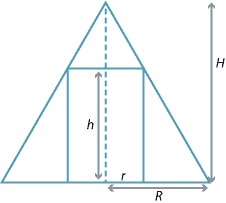
V = \pi r^2 h.
\] Using similar triangles, we have \begin{align*} \dfrac{H-h}{r} &= \dfrac{H}{R} \\ HR-hR &= rH \\ h &= H-\dfrac{rH}{R}. \end{align*} Substitute for \(h\) in the formula for \(V\): \[ V = \pi r^2\Bigl(H-\dfrac{rH}{R}\Bigr) = \dfrac{\pi H}{R} \bigl( Rr^2 - r^3 \bigr). \] Differentiate with respect to \(r\): \[ \dfrac{dV}{dr} = \dfrac{\pi H}{R} \bigl( 2Rr - 3r^2 \bigr) = \dfrac{\pi H r}{R} \bigl( 2R - 3r \bigr). \] Check for stationary points: \(\dfrac{dV}{dr} = 0\) implies \(r = \dfrac{2R}{3}\), since \(r\neq 0\). The second derivative is \[ \dfrac{d^2V}{dr^2} = \dfrac{\pi H}{R} \bigl( 2R - 6r \bigr). \]So, when \(r = \dfrac{2R}{3}\), we have \(\dfrac{d^2V}{dr^2} = -2\pi H < 0\). A local maximum occurs when \(r = \dfrac{2R}{3}\). This gives the maximum volume of the cylinder, which is \(V = \dfrac{4\pi R^2H}{27}\).
Exercise 12
The point \(P\) is moving along the curve \(y = \sqrt{x^3+56}\). We have
\[ \dfrac{dy}{dx} = \dfrac{3x^2}{2\sqrt{x^3+56}}, \]and so
\[ \dfrac{dx}{dt} = \dfrac{dx}{dy} \times \dfrac{dy}{dt} = \dfrac{2\sqrt{x^3+56}}{3x^2} \times \dfrac{dy}{dt}. \]When \(x=2\), we are given that \(\dfrac{dy}{dt} = 2\), and so
\[ \dfrac{dx}{dt} = \dfrac{2\sqrt{2^3+56}}{3 \times 2^2} \times 2 = \dfrac{8}{3}. \]Exercise 13
Assume the meteor is a sphere of radius \(r\). Its surface area is \(S = 4\pi r^2\), and its volume is \(V = \dfrac{4}{3} \pi r^3\). The volume is decreasing at a rate proportional to the surface area. That is,
\[ \dfrac{dV}{dt} = -kS = -4\pi k r^2, \]for some positive constant \(k\). Using the chain rule, we have
\[ \dfrac{dr}{dt} = \dfrac{dr}{dV} \times \dfrac{dV}{dt} = \dfrac{1}{4\pi r^2} \times -4\pi k r^2 = -k. \]So the radius is decreasing at a constant rate.
